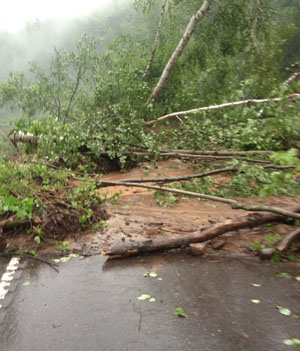By Jessica Wiens

Todd Campbell, District 1 project manager, discusses Hwy 210 flood damage with Bernie Arseneau, deputy commissioner and chief engineer. Eight miles of Hwy 210 through Jay Cooke State Park remain closed due to major flood damage. Photo by Jessica Wiens
|
Widespread rain engulfed Duluth and the surrounding area June 19-20, causing the worst flooding the region experienced in recorded history. The powerful water ripped pavement from the roads, destroyed bridge decks and created several sinkholes throughout northeastern Minnesota.
“The flooding affected almost every corridor within 50 miles of Duluth at one time or another,” said Duane Hill, District 1 engineer. “As the water receded in some areas, it rose in others. In particular, the McGregor and Moose Lake areas had flood crests much later than the immediate flooding in Duluth.”
According to Hill, Lake Superior rose four inches after the event, and the storm dropped enough water in the area to fill Mille Lacs Lake.
“The remarkable thing is there were no deaths or serious injuries in Minnesota caused by the flooding,” said Hill. “I’m so thankful for the MnDOT employees from District 1 and other areas who dropped their regular work to help when we needed it.”
Closures remain
The Minnesota State Patrol and District 1 crews closed about a dozen highways and Interstate 35; many of these roads were closed in multiple locations. Most roads are now open because crews completed temporary repairs, but work remains to finish more permanent solutions. Two roads are still closed:
- Hwy 2 from Proctor to Duluth
- Hwy 210 through Jay Cooke State Park (eight miles)
Crews plan to complete permanent repairs to Hwy 2 this season, but Hwy 210 is another story. Work to clean and repair several washouts, landslides and inslope failures on Hwy 210 will take much longer to complete. But Hill says it may be possible to construct temporary repairs on Hwy 210 this season.
“We need to get creative with the Hwy 210 repairs and try out a few innovative things we haven’t done before to find the best solution,” Hill said.
Jay Cooke State Park remains closed because Hwy 210 is the only access to the park for vehicles.
Current estimates to repair all flood damage is $55 million.
Help by the hundreds
District 1 employees responded immediately to monitor flood damage, set-up barricades, create GIS maps and establish internal and external communications channels.
Soon after, Districts 2, 3 and Metro arrived with personnel and traffic control equipment to assist. The Metro District also brought some heavy equipment to help with initial repairs. The Bridge Office and Materials Office also helped in the field with reviewing damage and planning repairs.
“Northeastern Minnesota is accessible thanks to hundreds of MnDOT employees and other emergency responders who came together in a time of crisis,” said Commissioner Tom Sorel. “The department will continue to use every resource we have to manage the current situation, complete permanent repairs and help out our partners where we can.”
Through State Aid, MnDOT is also dispatching teams to inspect about 180 bridges and structures on county, city and township roads that were most affected by flooding. These inspections will help local governments submit documentation for federal and state assistance. The inspections will take about two weeks, and all repairs are anticipated to be complete within six months.
Just the beginning
The District 1 engineering staff broke into assessment teams for each major repair area to initially get roads open and then to coordinate permanent fixes. Several of the flood-damaged locations had construction projects occurring in the area, so contractors were already on site and able to help with immediate responses. Other areas will take a bit more time to get contractors out.
The process to get federal emergency relief funding for all of the permanent repairs continues. The Legislature also plans to hold a special session to discuss flood relief at the state level.
“We have a long road ahead of us to get back to the way things were,” Hill said.
Editor's note:
Commissioner Sorel and Deputy Commissioner Arseneau will conduct a webcast Thursday, July 12, at 1 p.m., that will discuss the department's response to the June flooding that occurred in the Duluth area, as well as the recently passed federal transportation bill. Employees can access the webcast at http://oitw2ksvideo1.ad.dot.state.mn.us/dot3.asx. The webcast will be rebroadcasted at Friday, July 13, at 10 a.m.
District 1’s Jim Kielty survives storm, says it wasn’t his time to go
By Beth Petrowske, District 1 Public Affairs

A large mudslide covers Hwy 210 in Jay Cooke State Park; the same slide that trapped Jim Kielty, District 1 south subarea supervisor, inside the park. Photo by Jim Kielty |
At about 10 p.m., June 19, District 1 crews were dispatched to Jay Cooke State Park after receiving reports of downed trees due to wind and torrential rain. About 45 minutes later, State Patrol Dispatch called Jim Kielty, District 1 south subarea supervisor, about a reported mudslide on Hwy 210 in the park. Kielty immediately headed out to the area to assess the situation.
“The storm was so intense that it made visibility nearly impossible,” Kielty said. “I soon realized that I would not be able to leave the park the same way I went in.”
Slides and washouts had trapped Kielty as well as a motorist, Danny Singpiel, who was traveling home after work.
“The storm was so intense that it felt like the rain was sandblasting my face,” Kielty said. “We decided it was safer to travel together. We traveled cautiously along the highway until we were stopped by a major washout—the road was gone.”
The men turned around, but didn’t go far before their path was blocked by a mudslide covering the road—the same stretch they had just traveled through.
“The eerie part of seeing the road gone and a muddy slope in its place was that if we had been there just a minute or two earlier, we would have been swept away and nobody would have ever known it,” Kielty said.
It was dangerous to stay where they were; and it was dangerous to try to walk out. As Kielty put it, “We had to pick our poison.”
Leaving their trucks behind, the two men began walking toward the Minnesota Power Thomson Hydro Station. It wasn’t far—only about 3/8 of a mile—but the walk was harrowing. They couldn’t look ahead due to the pelting rain, and looking down, they could barely see their feet. They had only a small flashlight to guide them through the darkness, the tangled web of downed trees and the mud, which was waist high in some places.
Kielty compared the sights and sounds to that of a war zone. The river roared as it swept nearby and the trees snapped and popped as they succumbed to the wind and water.
“One tree went scooting by us straight vertical,” Kielty said. “It must have been going 25 mph, and then it stopped and just disappeared as it fell into an abyss.”
In order to continue to the power station, they had to pass very near to where that tree disappeared. Kielty said this was one of the most “awakening, tense” points during the night.
The two rain-soaked men reached the station at about 2 a.m. Employees at Minnesota Power gave them coffee, cookies and a place to dry off and rest.
At about 5 a.m., the two men walked off through the rain to be evacuated. They crawled over downed trees and through the washout that had trapped them the night before. Shortly after 7 a.m., they were picked up on Jay Cooke Road by a work crew from MnDOT’s Carlton Truck Station.
After a couple of weeks to reflect on the dangers he faced that night, Kielty said, “I guess it wasn’t my time to go.”
Their mud-covered trucks must stay where they are until the road can be repaired—a lonely testament to the furious storm that changed Hwy 210 and the surrounding area forever. |
|



